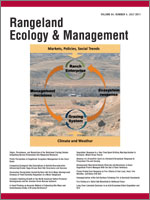Inter- (between years) and intra- (within year) annual variability of precipitation are high on rangelands. We used replicated rainout shelters in a southern tallgrass prairie ecosystem to decrease precipitation variability for 3 yr (1999–2001). We removed interannual variability in total precipitation plus either 1) interannual variability in the seasonal distribution of precipitation (seasonal distribution) or 2) all additional variability in precipitation, including within-year differences in precipitation (even distribution). Our objective was to determine if decreasing variability in precipitation elicits aboveground biomass and plant diversity responses. Aboveground biomass was harvested in June (peak biomass) and December (end of growing season). Plant species diversity, richness, and evenness were determined each June. Reducing precipitation variability had limited effects on total aboveground biomass, grass and forb biomass, and biomass of key species across the 3 yr of investigation. Species richness, species diversity, species evenness, and functional group richness and diversity all were similar across the precipitation treatments across years. Total aboveground biomass and biomass of the dominant C4 perennial grasses little bluestem (Schizachyrium scoparium) and Indiangrass (Sorghastrum nutans) generally were not responsive to the precipitation treatments. However, one species-specific response did occur with the annual forb firewheel (Gaillardia pulchella Foug.) displaying consistent increases in biomass in the seasonal distribution precipitation treatment across all 3 yr. This suggests that increased predictability of precipitation at a given stage of this species's growth can elicit changes in productivity of a single species that are not manifest at the community level due to constraints of the dominant species. These findings indicate that the southern tallgrass prairie ecosystem is adaptable to changes in precipitation to result in relatively stable production that facilitates simpler predictions in response to altered precipitation regimes.
How to translate text using browser tools
1 July 2011
Decreasing Precipitation Variability Does Not Elicit Major Aboveground Biomass or Plant Diversity Responses in a Mesic Rangeland
Justin D. Derner,
Karen R. Hickman,
H. Wayne Polley
ACCESS THE FULL ARTICLE

Rangeland Ecology and Management
Vol. 64 • No. 4
July 2011
Vol. 64 • No. 4
July 2011
altered precipitation regime
climate change
ecosystem stability
rainout shelter
Southern tallgrass prairie
species richness




